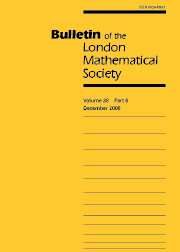Article contents
ABEL EQUATIONS: COMPOSITION CONJECTURES AND THE MODEL PROBLEM
Published online by Cambridge University Press: 01 May 2000
Abstract
We consider the Abel equation
formula here
where p and q are polynomials, and a is a fixed constant. We denote the solution of (1) by y(x, c), where y(a, c) = c. Standard existence theorems ensure that y(x, c) is well-defined and analytic in both its arguments, for c sufficiently small. If y(b, c) = c, then we call y(x, c) a periodic solution. Likewise, if y(b, c) ≡ c for all c close to 0, then we say that the system has a centre between a and b. The numbers a and b are not important; by a simple transformation, we can always choose a = 0 and b = 1, and we shall usually do so from now on.
Abel equations arise in several circumstances, but perhaps the main reason for their recent study is connected to the family of systems
formula here
where M and N are homogeneous polynomials of the same degree n. A transformation due to Cerkas allows us to bring these systems to the form (1), where p and q are now trigonometric polynomials. It is not hard to show that, setting a = 0 and b = 2π, the definitions of periodic solution and centre for (1) coincide with their usual definitions in the planar system (2). There are also transformations to Abel-type equations for more general systems; see [8, 10].
This trigonometric Abel equation has been used in a large number of works in order to estimate the number of limit cycles or obtain centre conditions, as well as in more general investigations relating the derivatives of the return map with iterated integrals. However, studying system (2) in whatever form is by no means easy, and a natural question is to ask whether we can still capture the essence of this problem if we take p and q to be polynomials, in the hope that the calculations will become easier. The recent series of investigations by Briskin, Françoise and Yomdin [3, 4, 5] seems to indicate that this could be the case.
Our interest here is to see what conditions the existence of a centre in (1) imposes on the defining equations. For ease of reference, we shall always denote the antiderivative of the polynomials p and q as P and Q; that is,
formula here
- Type
- NOTES AND PAPERS
- Information
- Copyright
- © The London Mathematical Society 2000
- 23
- Cited by




